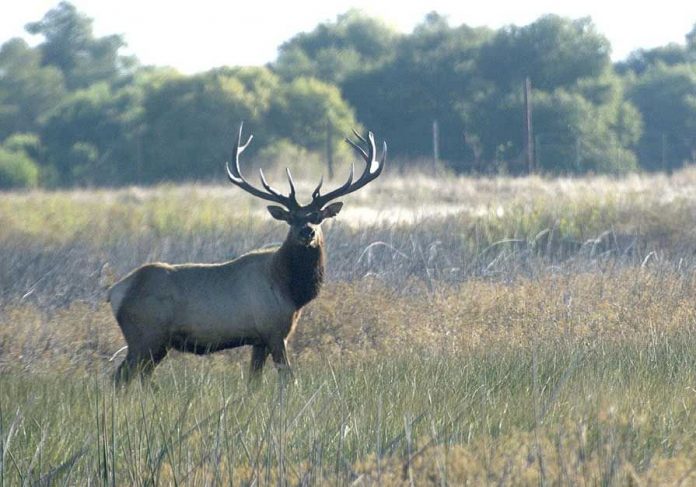
WHEN Europeans first arrived in California, 500,000 tule elk roamed the central and coastal valleys
of California. One early visitor described herds “as far as the eye could reach.” At the dawn of the 20th century, the rapacious ways of early settlers had reduced the sprawling herds to less than forty animals huddled in the tule marshes of Buena Vista Lake in Kern County. The lake sat on property that was part of a ranch owned by cattle king and land baron Henry Miller, who instructed his ranch hands to take all measures to protect the animals. From that seed group, a recovery program was launched.
For most of us, visions of elk are set somewhere high in the Rocky Mountains. But tule elk, the smallest elk subspecies, are endemic to California. What’s more, recovering populations live very close to us and are surprisingly easy to see.
Several weeks ago, a friend sent me a tip that the second annual Tule Elk Day was coming up at San Luis National Wildlife Refuge near Los Banos. Within the 26,877-acre refuge is a fenced enclosure that contains a captive herd of tule elk. Normally, elk viewing is limited to the five-mile road around the perimeter, but on Tule Elk Day refuge staff guide motorized tours inside the enclosure.
I signed up for the 8 a.m. tour, the earliest of the three scheduled for Tule Elk Day. After a brief introductory talk in front of the San Luis NWR visitor center, 12 of us climbed into two oversized vans, passed through the gate and began our bouncing trip through the 780-acre enclosure.
The rut, which runs from July through September, was drawing to a close. Right away, we saw an impressive male who must possess considerable elk charms. He intently followed our progress to ensure
we were no threat to his harem of perhaps 20 females, which comprised the vast majority of the females we saw during our tour. There were many other males roaming the preserve either alone or in small groups that had not been as successful.
It is exciting to see a full grown male tule elk roam the refuge. Their color is lighter than their Rocky Mountain brethren to match the color of the tawny grasslands they inhabit. Standing tall with a full rack of antlers, they are impressive animals. It taxed my imagination to learn that Roosevelt elk are nearly twice the size of an adult tule elk.
From the 18 animals placed in the enclosure in 1974, the herd quickly grew to exceed the area’s carrying capacity. Whenever the herd exceeds 50 animals, the people at California Department of Fish and Game look to move animals to distant free-roaming herds. Over the last 40 years, from San Luis NWR animals have helped establish 21 herds totaling 4,000 animals in grassland regions of California. The San Luis Reservoir herd that began with 24 elk has grown to exceed 400 animals. I regularly see members of that herd grazing beside Highway 152 just below San Luis Dam.
Make a note to attend Tule Elk Day next October. It was a unique opportunity to see these magnificent native California animals up close. During the hour-and-a-half tour, we saw adult males carrying impressive antler racks at nearly every turn. Midday, when I drove the perimeter loop outside the enclosure, I saw only a handful.
Until then, get up early and head to San Luis NWR. See tule elk from outside the enclosure and thrill at huge congregations of migrating waterfowl in flight. They are on the way.













